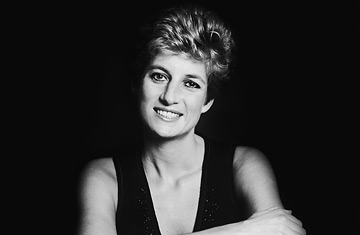
Diana, Princess of Wales, circa 1995.
And so it begins. The inquests into the deaths of Diana, Princess of Wales and Dodi Fayed finally kicked into gear on Tuesday, more than 10 years after the couple and their driver were killed in a car crash in Paris' Pont de l'Alma tunnel. That's 10 years of investigation, speculation and accusation, all building up to this point. But if Day One is any indication, anyone expecting a real-life episode of Law & Order to play out in London's Royal Courts of Justice will be sorely disappointed. The proceedings started as they are meant to go on: calmly, soberly and with a lot of information crammed into a relatively short space of time.
Setting the tone, Lord Justice Scott Baker, the coroner leading the inquests, began by reading his opening statement to the jury and drumming home the point that "this is not a trial." The six women and five men (only 11 jurors are required for an inquest) listened as Baker explained "in a nutshell" what evidence they would be hearing over the next six months and what they were expected to do with it all. Officially, an inquest tries to answer four key questions: who died, when, where and how? It is required by law whenever anyone dies of anything other than natural causes. But Diana and Dodi weren't just anyone. "Much has been written or broadcast [about their deaths]," Baker said, "often showing a disregard for the facts." So along with answering the four key questions, he gave the jury another task: "to allay suspicion and rumor," to give the public a chance to finally find out how Diana and Dodi died and "perhaps to learn lessons for the future."
In the seven hours that followed, Baker walked the jury through the events on the night of the crash and the two months leading up to it. Along the way, he plucked out — and then crushed — some of the main elements of Britain's favorite conspiracy theory; the same ones that Dodi's father, Harrods owner Mohamed Al Fayed, points to as evidence to support his allegation that the secret service murdered the couple on Prince Philip's orders.
He played down several issues that would have supported Al Fayed's obsessive quest. For example, the jury will have to consider whether or not Diana was pregnant when she died. But Baker showed them the photo that some say proves she was, one in which a swimsuit-clad Diana appears to have a rounded belly — then stated that it was taken before Diana and Dodi even met. On claims that the couple were engaged, Baker noted that, yes, Diana had once teased journalists with a promise that "you're going to get a big surprise" — but, again, that was before the two started dating.
If he seemed to be picking apart Al Fayed's case, Baker made it clear that the murder allegations would be taken seriously, that the inquests would explore all the points — 10 of them in total — that Al Fayed's legal team say support their claim that the crash was no accident, and that Al Fayed (or his lawyer, at least) will have his day in court.
But Baker was also sending out another message, more subtle, but just as clear: Move on folks, nothing to see here. By shooting down the juiciest rumors surrounding the inquests, Baker has cut the circus off at the pass. Now jurors, the press and the public know what's coming, there's no room for giddy speculation or shocking revelations from the stand. All that's left, Baker is hoping, is six months of just-the-facts and a chance for the world to finally put Diana to rest. Whether or not he gets what he wants — that's another question.
